Ming Dynastie
Authur: Robert F. Watson
Publisher: Hans im Glück
Year: 2007
review by

| x |
|
|
|
|
|
|
|
|
|
|
|
|
|
|
|
|
|
|
|
|
|
|
|
|
|
|
|
|
|
|
|
|
|
|
|
|
|
|
|
|
|
|
|
|
|
|
|
|
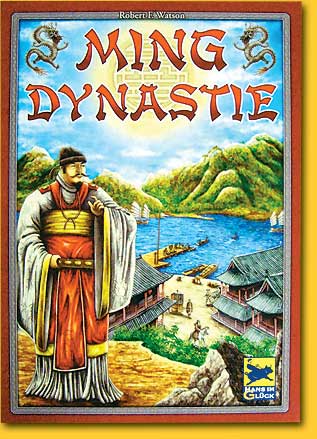 |
China, mid 14th century: the Mongols have just been successfully thrown out, and China is flourishing again. The princes and their relatives try to gather influence all over the rapidly developing country.
The map of China has been divided into six differently coloured provinces, that are all composed of three districts, with a city in the centre. Additionally, there are six boxes in the colours of the six provinces. Adjacent to each of these boxes one card is placed, forming the open display. Each player has one prince and 30 relatives in his colour. The prince is placed in a random province at the beginning of the game. Using cards, the princes can move around the country, and relatives can be placed in all the districts that the prince visits. Players can earn points for the majority of relatives in districts or cities.
|
|
|
|
| x |
|
|
|
|
|
|
|
|
|
|
|
|
|
|
|
|
|
|
|
|
|
|
|
|
|
|
|
|
|
|
|
|
|
|
|
|
|
|
|
|
|
|
|
|
|
|
|
|
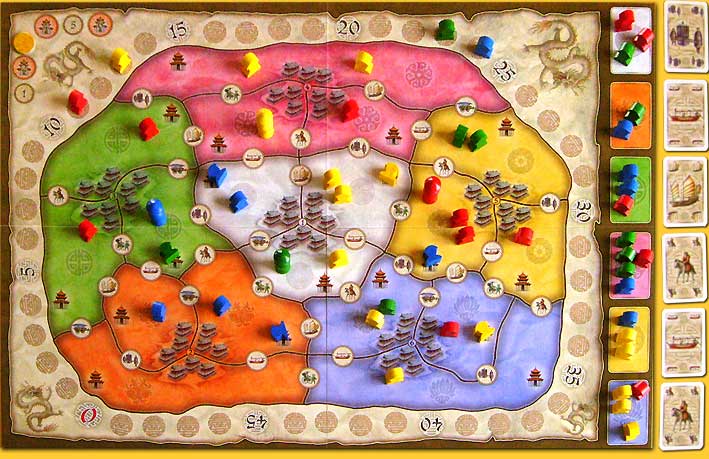 |
| x |
|
|
|
|
|
|
|
|
|
|
|
|
|
|
|
|
|
|
|
|
|
|
|
|
|
|
|
|
|
|
|
|
|
|
|
|
|
|
|
|
|
|
|
|
|
|
|
|
The game plays in six rounds, and after rounds 2, 4 and 6 there’s a scoring phase. Each round, the players receive five relatives. In the first phase they take turns in placing their relatives on one of the six coloured fields, until all relatives has been placed. Then, the players draw cards; they are only allowed to take a card from the open display adjacent to a field where they have placed at least one relative. This phase continues until all players have five cards.
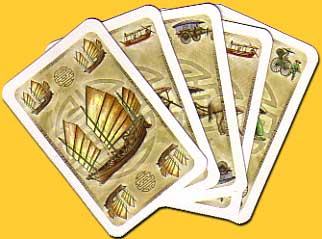 |
|
 |
|
|
|
| x |
|
|
|
|
|
|
|
|
|
|
|
|
|
|
|
|
|
|
|
|
|
|
|
|
|
|
|
|
|
|
|
|
|
|
|
|
|
|
|
|
|
|
|
|
|
|
|
|
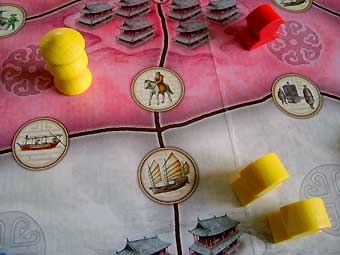 |
Subsequently, the princes can move through the country, by playing cards depicting the mode of transportation that is also displayed on the border they want to cross. If the player has relatives in the box with the same colour as the district where the prince ended his movement, he may place up to three relatives in this district. In each district, a monastery is depicted; a player is allowed to place one relative in the monastery. If the monastery is already occupied by another player, this relative is removed from the monastery and transferred into the district. The movement phase continues until all players have passed. |
|
|
|
| x |
|
|
|
|
|
|
|
|
|
|
|
|
|
|
|
|
|
|
|
|
|
|
|
|
|
|
|
|
|
|
|
|
|
|
|
|
|
|
|
|
|
|
|
|
|
|
|
|
| In rounds 1, 3 and 5 this is also the last phase: the players receive five new relatives and the next round begins. In round 2, 4 and 6 players score. In each district of all six provinces, the player with the majority of relatives in this district transfers two relatives to the city. The player with the second place transfers one relative to the city that is depicted in the centre of the province, on the border of the three districts. Relatives in the monastery do not count! For each relative that moved into the city, the player receives one chit in the colour of the province. |
|
 |
|
|
|
| x |
|
|
|
|
|
|
|
|
|
|
|
|
|
|
|
|
|
|
|
|
|
|
|
|
|
|
|
|
|
|
|
|
|
|
|
|
|
|
|
|
|
|
|
|
|
|
|
|
 |
After that players have the option to put their relatives back into the districts, for use in subsequent rounds. Alternatively, each relative that has remained in the city scores four points in round 2, three points in round 4 and no points in round 6. |
|
|
|
| x |
|
|
|
|
|
|
|
|
|
|
|
|
|
|
|
|
|
|
|
|
|
|
|
|
|
|
|
|
|
|
|
|
|
|
|
|
|
|
|
|
|
|
|
|
|
|
|
|
| In addition, four points are rewarded for the player that has the majority of relatives in that city. After that, all relatives are removed from the city and are out of the game. For each relative in a monastery, the owner receives 4 points, and if a player has a set of six chits of different colours (one from each province), he gets 28 points in round 2, 24 points in round 4 and 20 points in round 6. The player with the highest score after round 6 has won. |
|
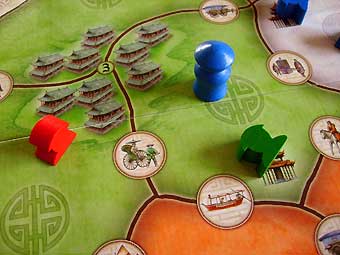 |
|
|
|
| x |
|
|
|
|
|
|
|
|
|
|
|
|
|
|
|
|
|
|
|
|
|
|
|
|
|
|
|
|
|
|
|
|
|
|
|
|
|
|
|
|
|
|
|
|
|
|
|
|
| x |
|
|
|
|
|
|
|
|
|
|
|
|
|
|
|
|
|
|
|
|
|
|
|
|
|
|
|
|
|
|
|
|
|
|
|
|
|
|
|
|
|
|
|
|
|
|
|
|
 |
|
|
|
|
|
|
|
|
|
|
|
|
|
|
|
|
|
|
|
|
|
|
|
|
|
|
|
|
|
|
|
|
|
|
|
|
|
|
|
|
|
|
|
|
|
It may sound a bit confusing at first: place relatives in a district, move them to the city, and back to the district again... but after a few rounds it all starts to make sense, and 'Ming Dynastie' turns out to be a great game with lots of strategic options. For example, one could try to go for the monasteries, that score 4 points per round, or one could go for the majorities in the cities. Alternatively, it is possible to try to get majorities in the district, that allows to transfer relatives to the city and receive chits, and after that place all of them back into the district again so they qualify in getting some chits again in the next round. This could possibly be a very successful strategy, since it gives a player a lot of points for sets of six different chits, thereby moving a player to the other end of the scoring track.
|
|
|
|
| x |
|
|
|
|
|
|
|
|
|
|
|
|
|
|
|
|
|
|
|
|
|
|
|
|
|
|
|
|
|
|
|
|
|
|
|
|
|
|
|
|
|
|
|
|
|
|
|
|
|
|
This is a point of concern: the 4 points a player gets for majorities in the cities don’t really compare to the 28, 24 or 20 points that are awarded for six chits. It is also strange that the scoring track stops at 50, while in an average four player game you easily score 180 points. Players keep taking ‘+50’ and ‘+100’ chits! Is there something against making the scoring track just a tad longer?
|
|
|
|
| x |
|
|
|
|
|
|
|
|
|
|
|
|
|
|
|
|
|
|
|
|
|
|
|
|
|
|
|
|
|
|
|
|
|
|
|
|
|
|
|
|
|
|
|
|
|
|
|
|
|
A nice element is that you are only allowed to take cards that are adjacent to a field where you have at least one relative; it seems attractive to put many relatives on one field, because if you place them in a district your majority is almost guaranteed, but the disadvantage is that you have very few cards to choose from, and maybe your prince won’t make it to the district of your choice because you lack the required cards! It is safer to place relatives on many different fields, but that makes it difficult to get majorities in the districts, and you risk not scoring any points at all...
|
|
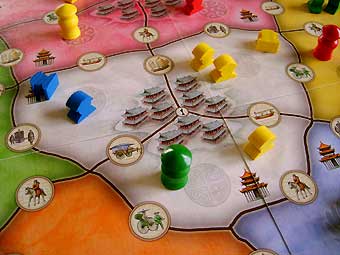 |
|
|
|
| x |
|
|
|
|
|
|
|
|
|
|
|
|
|
|
|
|
|
|
|
|
|
|
|
|
|
|
|
|
|
|
|
|
|
|
|
|
|
|
|
|
|
|
|
|
|
|
|
|
Altogether 'Ming Dynastie' is a fine game. The game board is maybe not extremely inspirational, but that adds only to the clarity and transparency, the cards with the different modes of transportation have beautiful illustrations, and the wooden prince and relatives also leave nothing to be desired. The six rounds are over before you know it, and the game doesn’t take longer than ninety minutes.
© 2007 Barbara van Vugt
Ming Dynastie, Robert F. Watson, Hans im Glück, 2007 - 2 to 4 players, 10 years and up, 90 minutes
|
|
|
|
  |
|
|
|
|
|
|
|
|
|
|
|
|
|
|
|
|
|
|
|
|
|
|
|
|
|
|
|
|
|
|
|
|
|
|
|
|
|
|
|
|
|
|
|
|
  |
Offers more tactics than one would initially suspect - but the points galore for the chits is over the top |
|
|
|
  |
|
|
|
|
|
|
|
|
|
|
|
|
|
|
|
|
|
|
|
|
|
|
|
|
|
|
|
|
|
|
|
|
|
|
|
|
|
|
|
|
|
|
|
|
  |
|
|
|
|
|
|
|
|
|
|
|
|
|
|
|
|
|
|
|
|
|
|
|
|
|
|
|
|
|
|
|
|
|
|
|
|
|
|
|
|
|
|
|
|
  |
|
|
|
|
|
|
|
|
|
|
|
|
|
|
|
|
|
|
|
|
|
|
|
|
|
|
|
|
|
|
|
|
|
|
|
|
|
|
|
|
|
|
|
|
| x |
|
|
|
|
|
|
|
|
|
|
|
|
|
|
|
|
|
|
|
|
|
|
|
|
|
|
|
|
|
|
|
|
|
|
|
|
|
|
|
|
|
|
|
|
|
|
|
|
| x |
|
|
|
|
|
|
|
|
|
|
|
|
|
|
|
|
|
|
|
|
|
|
|
|
|
|
|
|
|
|
|
|
|
|
|
|
|
|
|
|
|
|
|
|
|
|
|
|
 |
|
|
|
|
|
|
|
|
|
|
|
|
|
|
|
|
|
|
|
|
|
|
|
|
|
|
|
|
|
|
|
|
|
|
|
|
|
|
|
|
|
|
|
|
 |
|
|
|
|
|
|
|
|
|
|
|
|
|
|
|
|
|
|
|
|
|
|
|
|
|
|
|
|
|
|
|
|
|
|
|
|
|
|
|
|
|
|
|
|
| x |
|
|
|
|
|
|
|
|
|
|
|
|
|
|
|
|
|
|
|
|
|
|
|
|
|
|
|
|
|
|
|
|
|
|
|
|
|
|
|
|
|
|
|
|
|
|
|
|
 |
|
|
|
|
|
|
|
|
|
|
|
|
|
|
|
|
|
|
|
|
|
|
|
|
|
|
|
|
|
|
|
|
|
|
|
|
 |
|
|
|
|
|
|
|
|
|
|
|
|
|
|
|
|
|
|
|
|
|
|
|
|
|
|
|
|
|
|
|
|
|
|
|
|
|
|